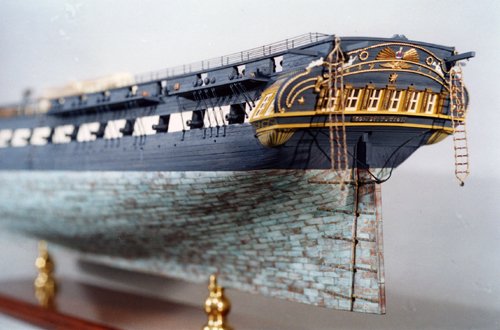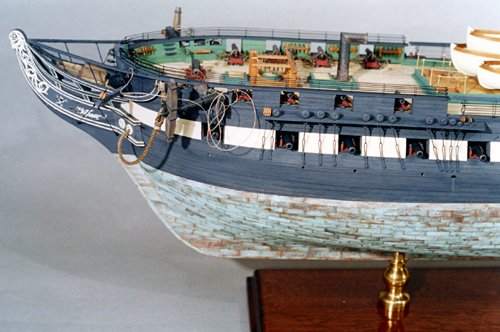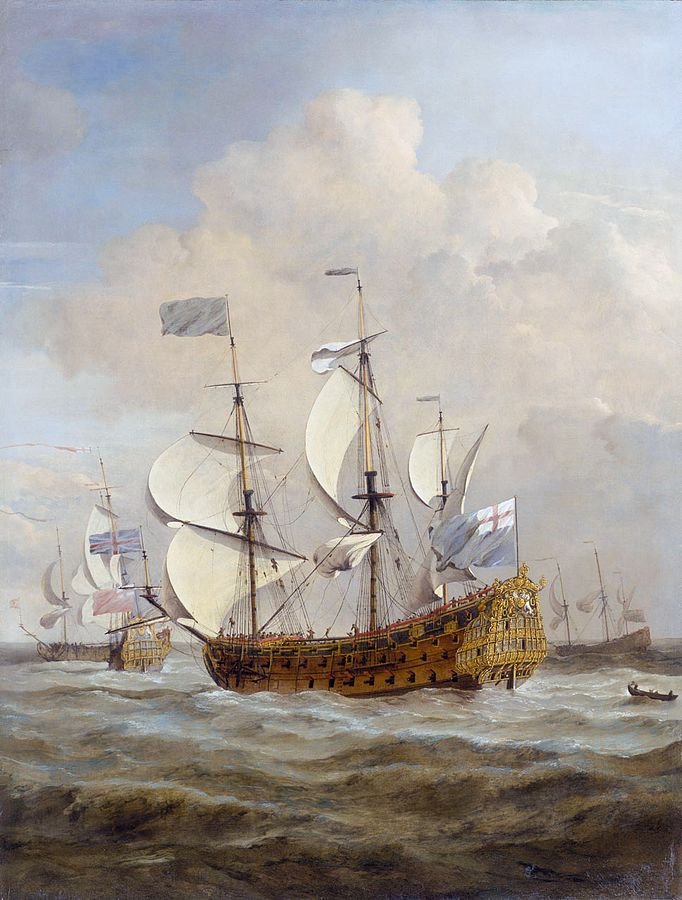-
Posts
841 -
Joined
-
Last visited
Content Type
Profiles
Forums
Gallery
Events
Everything posted by michaelpsutton2
-
I have been looking for a bit now and have yet to find a contemporary picture of a sailing ship of the American Navy showing crowsfeet and euphroes. I realize they are seldom shown, but I find none. Were they used in the U.S. Navy?
-

What sails did a ship like Vasa have set in severe weather?
michaelpsutton2 replied to ubjs's topic in Nautical/Naval History
The superstructures of the hulls of these "galleon" like ships were a sail unto themselves. Drifting downwind in gale almost provided steerageway. A lee shore was death in a bottle as there is no way to take a reef in a poop deck. -
Great work as always
-

USS Delaware 1817 by threebs
michaelpsutton2 replied to threebs's topic in - Build logs for subjects built 1801 - 1850
I gotta ask here. Are there any plans for Kearsage availabe. I konw of very little info for the 1850's and 60's except for the ironclads. -
in a brig rig particularly a larger brig with a "made mast" it was difficult to get the hoops on the spanker to slide up and down over the mast bands and fish. The snwhad the spanker on a smaller diameter and more importantly smooth pole. In some snows the sail was laced to the mast and did not use wooden hoops. here is a detail from the sail plan of the USS Chipewa
-
The individual plates should be scaled to represent about 14" X 48"
- 74 replies
-
- mantua
- thermopylae
-
(and 1 more)
Tagged with:
-
Looking at Toms plan at the head of this thread, I can imagine that there must have been some way to climb to the t'gallant rigging stop, but not to the truck. All I need is about 10 minutes in 1790 with a half decent camera and I could answer so many of my own questions.
-
Last night a went through my files. I do not have a single original contemporary sail plan for a US naval ship showing topgallant ratlines. Zero. Can't say what that means, but they aren't in the plans. You can imagine some bosun's mate going"F these plans,I'm putting something to climb on!"
-
My gerneral impression is that the t'gallant yard would be lowered to the topmast cap and that someone standing on the the topmast tressletrees would gather and furl the sail. The yard would then be lashed up there or lowered to the deck. All that changed when royals and even skysails became the norm. At that point the t'gallant was rigged and handled more like the topsail . This absolutely becomes true when the t'gallant has a reef band.
-
Yes! I believe the yard came down with the sail furled tightly. Attached is a pic showing a t'gallant being hoisted or lowered with the wind being spilled from the sail. One sheet may have been let go. Is doused the right word?
-
The royal yard was often set flying that is without even braces. II do not believe I have ever seen a contemporary portrayal of ratlines, a rope ladder of knotted rope for royals. But it may just be an omission ob the part of artisits and model makers. Somewhere in the "Naval Doc's relating to the quasi war with France I read about "the skysail yard" being brought to the deck with the sail furled on the yard. It is possible in earlier times the royal was treated the same way. If you look at paintings for the last two decades of the 18th century, very few show royal yards"lowered with sails furled. The only times a royal yard is shown is if the sail is set. I will see if I can find it but a saw one pic of an English frigate (Napoleanic period), royal yard with furled sail lashed vertically against the t'gallant mast down in the topmast head. The idea must have been to reduce strain on the mast.
-
It was common to lower the t'gallant yard before furling. This took some of the strain off of the upper top hamper immediately. When the yard was down on the cap, it could be reached while still standing on the trees. This was particularly true before royal became common.
-

Cutter Grace 1763
michaelpsutton2 replied to tabycz's topic in CAD and 3D Modelling/Drafting Plans with Software
Might it contain water coming up past the rudder coat? Assuming they had one. In any kind of a following sea with that overhanging transom you could likely store live halibut in there -

Yard height on 18th century Cutter
michaelpsutton2 replied to michaelpsutton2's topic in Masting, rigging and sails
Yes I saw that drawing a couple of years ago. I even have it on my computer but had completely forgotten it was there. Thanks, It is of course Danish, but the proportions of the rig are very similar to those of an English cutter. The only real difference is on the main sail. I have never seen a painting etc that shows the sail hooked to both the spreading yard and the smaller crossjack. Makes for a unique shape. The mainsail fills the huge roach on the topsail. You gotta wonder why they just didn't reduce the roach, lace the mainsail to the"spreading yard, throw the little crossjack over the side and call it a day . -

Yard height on 18th century Cutter
michaelpsutton2 replied to michaelpsutton2's topic in Masting, rigging and sails
Which yard is at the futtock stave,the spreading yard or the crossjack yard? Remember this is a cutter rig 1776 -
How does one decide at what heights the various (spreading, crossjack, topsail & topgallant) yards are hoisted with sails set. I have seen illustrations of course, but no real guides. What is the masthead length? And I get the impression that the spreading yard was quite a bit below the hounds. Just for the record I am attempting to reconstruct the sail plan of the sloops built for Lake Champlain in 1776. There is an interesting plan at NMM with spar dimensions.
-
Every time I check in to see the new ones, I end up looking all he way through from the first one. I cannot believe you can do this kind of work in an afternoon. That's skill and confidence.
-

What is "flat-floored, apple-cheeked hull"
michaelpsutton2 replied to RussR's topic in Nautical/Naval History
In "flat floored ships" the piece of the frames that crossed over the keel tended to extend out straighter rather than rising. As I result as you can see from the above illustration, the turn of the bilge on flat floored ships was lower than on sharp built. Among other benefits it allowed ships such as the Resolution to remain upright when grounded at low tide in shallow undeveloped harbors. The Resolution had been in the coastal coal trade where good moorings were few and far between. These ship could carry more cargo for their registered tonnage than so called clippers, an early tax advantage of a kind. An extreme version of this hull form was the kettle bottom used in the mid 19th century in the United States. -
hull design is a series of trade offs. Carrying capacity vs speed is one of the biggest. A sharp ship in general is one thst the requirements for speed and performance were more heavily factored in than say crrying capacisty or stability. Familiarize yourself with the concept of block co-efficient. Generally a sharp ship of any rig(ship, barque, schooner) has a lower block co-efficient.
About us
Modelshipworld - Advancing Ship Modeling through Research
SSL Secured
Your security is important for us so this Website is SSL-Secured
NRG Mailing Address
Nautical Research Guild
237 South Lincoln Street
Westmont IL, 60559-1917
Model Ship World ® and the MSW logo are Registered Trademarks, and belong to the Nautical Research Guild (United States Patent and Trademark Office: No. 6,929,264 & No. 6,929,274, registered Dec. 20, 2022)
Helpful Links
About the NRG
If you enjoy building ship models that are historically accurate as well as beautiful, then The Nautical Research Guild (NRG) is just right for you.
The Guild is a non-profit educational organization whose mission is to “Advance Ship Modeling Through Research”. We provide support to our members in their efforts to raise the quality of their model ships.
The Nautical Research Guild has published our world-renowned quarterly magazine, The Nautical Research Journal, since 1955. The pages of the Journal are full of articles by accomplished ship modelers who show you how they create those exquisite details on their models, and by maritime historians who show you the correct details to build. The Journal is available in both print and digital editions. Go to the NRG web site (www.thenrg.org) to download a complimentary digital copy of the Journal. The NRG also publishes plan sets, books and compilations of back issues of the Journal and the former Ships in Scale and Model Ship Builder magazines.




PLANS.thumb.jpg.4b0a9a945d8ca17540e683d46c47cde5.jpg)
sailplan.thumb.jpg.96a6e9941c716fb641d44b51880d857b.jpg)


